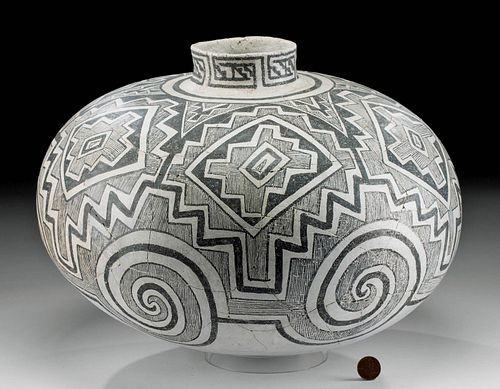Large Native American Tularosa Pottery Jar
Lot 228
About Seller
Artemis Gallery
686 S Taylor Ave, Ste 106
Louisville, CO 80027
United States
Selling antiquities, ancient and ethnographic art online since 1993, Artemis Gallery specializes in Classical Antiquities (Egyptian, Greek, Roman, Near Eastern), Asian, Pre-Columbian, African / Tribal / Oceanographic art. Our extensive inventory includes pottery, stone, metal, wood, glass and textil...Read more
Categories
Estimate:
$8,000 - $12,000
Absentee vs Live bid
Two ways to bid:
- Leave a max absentee bid and the platform will bid on your behalf up to your maximum bid during the live auction.
- Bid live during the auction and your bids will be submitted real-time to the auctioneer.
Bid Increments
| Price | Bid Increment |
|---|---|
| $0 | $25 |
| $300 | $50 |
| $1,000 | $100 |
| $2,000 | $250 |
| $5,000 | $500 |
| $10,000 | $1,000 |
| $20,000 | $2,500 |
| $50,000 | $5,000 |
| $100,000 | $10,000 |
| $200,000 | $20,000 |
About Auction
By Artemis Gallery
Mar 24, 2022
Set Reminder
2022-03-24 10:00:00
2022-03-24 10:00:00
America/New_York
Bidsquare
Bidsquare : Exceptional Antiquities Ethnographic Fine Art
https://www.bidsquare.com/auctions/artemis-gallery/exceptional-antiquities-ethnographic-fine-art-9057
Museum-worthy examples of classical antiquities (Egyptian, Greek, Roman, Near Eastern), Viking, Far East / Asian, Pre-Columbian, African / Tribal, Oceanic, Native American, Spanish Colonial, Fossils, Ancient Jewelry, Fine / Visual Arts, so much more! Artemis Gallery info@artemisgallery.com
Museum-worthy examples of classical antiquities (Egyptian, Greek, Roman, Near Eastern), Viking, Far East / Asian, Pre-Columbian, African / Tribal, Oceanic, Native American, Spanish Colonial, Fossils, Ancient Jewelry, Fine / Visual Arts, so much more! Artemis Gallery info@artemisgallery.com
- Lot Description
Native American, southwestern United States, New Mexico, Ancestral Puebloan (Anasazi) period, Tularosa, ca. 900 to 1450 CE. A stunning pottery bowl of an impressive scale, presenting a globular body, a curved shoulder, a narrow, cylindrical neck, and a gently flared rim, all sitting upon a round yet stable base. Adorned with skillfully painted black on white decoration, the voluminous vessel boasts a complex decorative program of striated, spiral, and geometric designs. First, the exterior of the rim is embellished by 6 square-shaped spirals, each filled with 3 diagonal lines of steppe motif. The base of the neck is then encompassed by 2 circles with the innermost showing a gap known as the "spirit break," believed to metaphorically release the spirit of the potter or any other spirits that may be associated with the materials that make up the pot. Size: 12.7" Diameter x 10.2" H (32.3 cm x 25.9 cm)
A series of 6 outward pointing triangles is placed along the outer circle, forming a 6-pointed star. The remainder of the exterior features 6 rhomboid sections with zigzag borders filled with squares and steppe motif designs, with 6 large spirals below. All is filled with series of tightly packed horizontal and vertical linear striations.
Tularosa pottery from the Starkweather Ruin has been divided into three styles - Wingate, Snowflake and Tularosa - reflecting similarities in decoration with their source types. Classic Tularosa Style designs are based on spirals, a diagnostic feature of the type. However, the spiral-stairstep motif that we see in this example is considered to be the most advanced development.
Many groups of indigenous peoples occupied the Tularosa region before the Apache drove them out in the 1800s. While some settled elsewhere; some groups completely disbanded. The Tularosa Basin in New Mexico was a rich source of Paleo Native American sites. Very little was known about the life of the Tularosa Basin; however, scholars have determined that the Anasazi and Mogollon peoples resided in the Tularosa Basin. The Anasazi culture existed from approximately 200 to 1300 CE, and their movement from the Tularosa Basin to the pueblos of the southwest has been identified. Tularosa is a village in Otero, New Mexico that shares its name with the Tularosa Basin where the town is located.
Cf. Art Institute of Chicago, 1978.316, Cleveland Museum of Art, 1984.159, and Arizona Museum of Natural History, 2012.164.8.
Provenance: private Hidden Valley Lake, California, USA collection
All items legal to buy/sell under U.S. Statute covering cultural patrimony Code 2600, CHAPTER 14, and are guaranteed to be as described or your money back.
A Certificate of Authenticity will accompany all winning bids.
PLEASE NOTE: Due to recent increases of shipments being seized by Australian & German customs (even for items with pre-UNESCO provenance), we will no longer ship most antiquities and ancient Chinese art to Australia & Germany. For categories of items that are acceptable to ship to Australia or Germany, please contact us directly or work with your local customs brokerage firm.
Display stands not described as included/custom in the item description are for photography purposes only and will not be included with the item upon shipping.
#170459Restoration to about 1/6 of body, but only evident on interior. Repaired from several pieces with break lines visible. Some small areas of repainting. A few minor areas of loss along break lines. Two drill holes in 1 area from repair process. Light chipping to rim, as well as expected nicks, abrasions, and pitting throughout, all commensurate with age. Otherwise, excellent with impressive remaining pigments.Condition
- Shipping Info
-
All shipping is handled in-house for your convenience. Your invoice from Artemis Gallery will include shipping calculation instructions. If in doubt, please inquire BEFORE bidding for estimated shipping costs for individual items.
-
- Buyer's Premium



 EUR
EUR CAD
CAD AUD
AUD GBP
GBP MXN
MXN HKD
HKD CNY
CNY MYR
MYR SEK
SEK SGD
SGD CHF
CHF THB
THB















